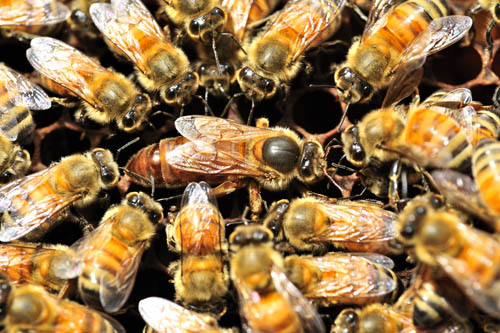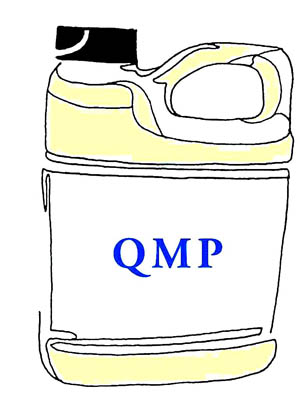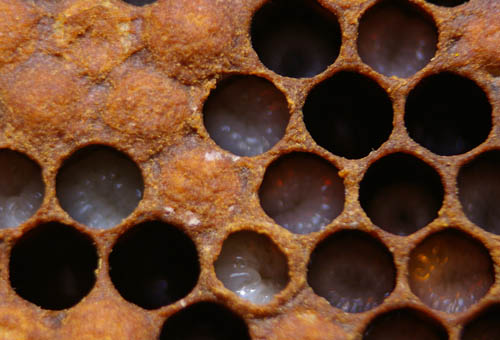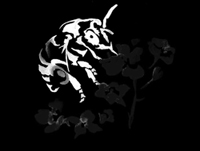Chemical Manipulation of Pollinator Behaviour
There are chemicals available on the market that mimic the pheromones honey bees use to communicate. Some can be sprayed on a crop to attract bees - in theory these improve pollination by drawing bees into the crop and reducing competition from more attractive blooms elsewhere. This can be particularly useful in crops that are not particularly attractive to honey bees. Others manipulate behaviour inside the hive, and encourage foraging activity in general. These products have had mixed results in the field, and additional research may lead to more effective use specific crops.
Queen Mandibular Pheromone (QMP) is a group of (at least) five active compounds produced by queen honey bees. The pheromone aids in queen control of the colony and colony cohesion. Products containing synthetic QMP, such as FruitBoost™, are used to increase foraging activity of worker bees when sprayed on a crop. Elevated levels of QMP are also correlated with increased pollen foraging activity, which can translate to higher rates of flower visitation.

A honey bee queen attended by worker bees. The same pheromones that control
worker bees in the colony can enhance foraging activity when sprayed on a crop
Some believe that synthetic QMP lacks one or more components present natural QMP, and thus may not be as effective as claimed. Again, mixed results have been found in the field. An application of FruitBoost™ was unable to improve pollination in watermelon when more attractive sunflower was blooming nearby. In tree fruits, there was no effect of QMP on yield or fruit quality in apple or sweet cherry orchards, but a a significant economic return could be achieved in pear, which is normally unattractive to pollinators due to low-quality nectar. It was also possible to increase yields in cranberry and blueberry, although it was also possible to concentrate the QMP too strongly, which deterred visiting honey bees.

Synthetic queen mandibular pheromone can be sprayed on a crop to
increase foraging activity and pollination (illustration by Cara Dawson)
Brood pheromone is produced by salivary glands in honey bee larvae. It tells worker bees that larvae are present and require pollen. A commercial formulation (SuperBoost™) placed inside a colony will simulate the presence of more brood, which encourages foragers to collect more pollen and visit more flowers. Experiments in cucurbit fields showed that the product led to a higher proportion of pollen foragers and larger pollen loads carried from the target crop. It may also have benefits for the colony, including the production of more brood and honey, increased potential for colony splitting, and improved overwintering success. From a pollination standpoint, the use of brood pheromone in this manner results in more pollen and nectar foragers, higher flower visitation rates, greater pollen loads and more pollen brought back to the hive, and more adult bees.

Honey bee larvae in cells; pheromones released from the larvae can stimulate
foraging by worker bees (photo © Max Westby)
BeeScent™ is a commercial blend of pheromones that is believed to attract bees when sprayed onto a blooming crop. It includes a synthetic Nasonov pheromone, which is a cocktail of compounds secreted by bees that attracts bees and leads to cohesion among nestmates. It will cause bees to congregate in an area, and may be used by beekeepers to attract and capture swarms. It is also used by bees in the field to recruit other foragers to high quality sources of food and water. One study found increases of 50-100% in bee activity in sprayed crops; however, it is not certain if BeeScent™ is more attractive that other odours detectable by the bees, such as cinnamon oil, or improves productivity or profitability in the crops to which it is applied.
BeeLine™ differs from the other products discussed here in that it is not a pheromone, but rather a wettable powder food supplement. It contains sugars, fats, proteins, and other nutrients, and is intended to attract bees and other pollinators to the crop and stimulate their desire to feed. Some trials have had disappointing results in both the ability of BeeLineTM to attract bees, and to improve seed sets or yields. However, even if pollination is not improved, it is likely to improve the health of the visiting insects.
